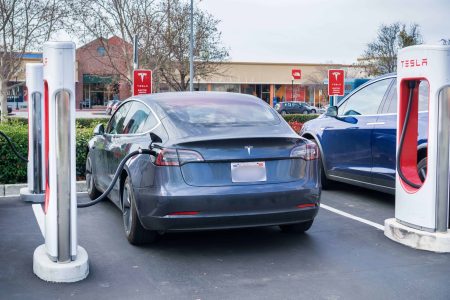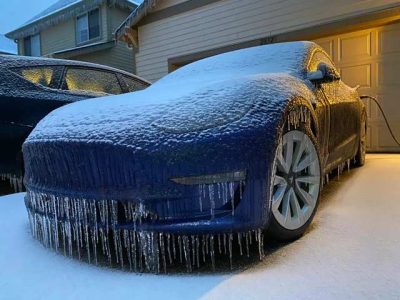12 Myths About Electric Vehicles:
Debunked
Electric vehicles (EVs) are becoming increasingly popular. However, with this growing popularity comes a host of myths and misconceptions surrounding EVs.
It’s time to come clean about the myths surrounding Electric Vehicles. Newer EVs have excellent range, are exceptionally safe, powerful, reliable, comfortable and great for daily commutes. Advanced battery and thermal management systems make cold climate charging easy and EVs can save drivers thousands of dollars over the long term.
Myth #1:
EVs have a limited range and require frequent charging.
EVs have a range of 100-405 miles (161-652 km), depending on the vehicle. For most people, that’s more than enough for daily commuting and running errands without having to worry about charging. It’s also comparable to the average range (300 miles/482 km) you’d get from a traditional tank of gas.
Range Anxiety
Range anxiety is common among new and prospective EV owners, but you can relax knowing that you can go a long ways before needing to charge.
While it is true that some older models of EVs had a limited range, modern EVs like the Tesla Model S can travel over 400 miles on a single charge.
To be fair, the range of an EV can be affected by factors such as:
- weather conditions
- driving habits (high speeds, use of air conditioning or heating)
- terrain (uphill)
- tires
- preconditioning
As a result, it’s a good idea for EV owners to plan their routes carefully and be mindful of their driving habits to ensure they get the most out of their vehicle’s range.
EVs like Tesla will analyse your recent driving habits to provide an accurate range estimate, and their navigation systems will direct you to the closest charging station.
Charging
Drivers that are thinking about getting an EV often worry that it will be inconvenient to charge their vehicles. In fact, charging at home or away is simple and convenient.
In fact, many EV owners have reported that charging their vehicle is often more convenient than stopping at a gas station, as they can simply plug in their car overnight and wake up to a fully charged vehicle.

Several EVs now offer fast charging options, which can significantly reduce the amount of time it takes to charge the vehicle. For example, the Tesla Supercharger network can charge a Model S to 80% in just 40 minutes. Since Superchargers are often located near malls and restaurants, it’s convenient to charge while you’re grabbing lunch or a latte.
Many charging stations are now standardizing equipment to accommodate a variety of EVs in an expanding charging network.
Myth #2:
EVs are expensive.
EVs are slightly more expensive upfront but can save drivers thousands of dollars over the long term in maintenance and operating costs.
Upfront Cost
Some high-end luxury models like the Tesla Model S can be expensive, but the market is booming with more affordable options like the Nissan Leaf and Chevy Bolt.
In fact, the price of EVs has been steadily declining over the past few years, making them more accessible to a wider range of consumers. The Model 3 is Tesla’s most modestly priced vehicle, but the company is planning to build a small inexpensive vehicle under $25,000 called the Tesla Model E and hopes to have it released in the next few years.
One of the main reasons that EVs are slightly more expensive upfront is the cost of the battery pack. However, as battery technology continues to advance, prices are expected to decline. Additionally, many governments and utilities offer incentives and rebates to help offset the cost of purchasing an EV, further reducing the upfront cost for consumers.
For faster charging at home, some people pay about $1000 to install a Level 2 charger but this is not necessary, especially with the expansion of charging station networks across the country.
Long Term Savings
Once you purchase an EV, you can enjoy the benefits of long term savings from lower maintenance costs and gasoline savings.

Studies have shown that over the life of a vehicle, an EV is cheaper to own and operate than a traditional car:
- EVs require next to no maintenance as they have fewer moving parts. They don’t require oil changes, belt replacements, spark plug replacement or other routine maintenance.
- EVs are cheaper to operate. The US Department of Energy suggests that EVs cost 4 cents less per mile to operate than traditional internal combustion engine (ICE) vehicles.
- If you keep your vehicle for 300,000 miles you can expect to save $12,000 with an EV.
- Although there are large variations in electricity and gasoline prices depending on your country and state, the average operating cost of an EV is about $485 per year, as compared with $1117 for a gasoline-powered vehicle.
So while it’s true that EVs may be more expensive upfront, the long-term savings make them a smart investment.
Myth #3:
EVs are slow and lack power.
Modern EVs provide instant torque and smooth, consistent power delivery. This makes them some of the fastest, smoothest and most powerful vehicles on the road, even smoking high end sports cars like the Porsche and Lamborghini.
Acceleration and Speed
Earlier EVs were designed for city driving and had limited power and range. However, modern EVs have completely shattered this myth. The Tesla Model S Plaid, for example, can go from 0 to 60 mph in 2.1 seconds and has a top speed of over 200 mph (322 km), which is comparable to many high-end gasoline-powered sports cars.
Electric motors provide instant torque, making them capable of delivering impressive acceleration and speed. In contrast, internal combustion engines (ICE) in gasoline-powered cars need to build up RPMs in order to generate power, which results in slower acceleration.
Myth #4:
EVs are not as safe as gasoline-powered cars.
EVs are designed and proven to be among the safest vehicles on the planet in design, fire and crash safety.
Design
EVs are designed with advanced safety features that are not available on traditional ICE cars:
- EV battery packs are located beneath the car, which helps to lower the center of gravity and reduce the risk of rollover accidents.
- The heavier weight of EVs tends to push other obstacles around and transfer the collision energy away from passengers.
- The absence of an internal combustion engine (ICE) in an EV means that there is no risk of a fuel tank explosion, which can occur in gasoline-powered cars.
- EVs are typically equipped with automatic emergency braking, which can help to prevent or mitigate collisions.
- Many EVs have features like lane departure warnings, blind spot detection, and rearview cameras that can help drivers avoid accidents.
- Electric motors provide instant torque, which gives EVs excellent acceleration and handling, making them more maneuverable in dangerous situations. This can be especially important when it comes to avoiding accidents or making sudden evasive maneuvers to avoid obstacles.
- EVs are often built with robust structures that can withstand collisions. For example, the Tesla Model S has a reinforced aluminum frame and a crash structure that can absorb and redirect impact forces away from the passengers.
Fire Data
There is no evidence to suggest EVs are more prone to spontaneous, accidental or non-vehicle related fires than traditional vehicles. In fact, EVs have lower rates of fire than traditional ICE vehicles. Hybrids fared the worst when it came to fire safety.
As an example, between 2012 – 2021, Tesla reported they had one Tesla vehicle fire for every 210 million miles traveled. By comparison, data from the National Fire Protection Association (NFPA) and U.S. Department of Transportation reported one vehicle fire for every 19 million miles traveled. That’s more than a 10-fold difference in Tesla’s EV fire safety.
Tesla even used data that was comparable to NFPA’s own statistics and included vehicle fires caused by structure/house fires, arson, and reasons completely unrelated to the vehicle.
Crash Data
When it comes to crash-test performance and injury claims, EVs as a group rank as safe or safer than traditional ICE vehicles:
- Injury claims. Insurance claims are 40% lower in EVs than traditional vehicles.
- Superior Safety Awards. Some EVs (like Tesla Models 3 & Y, Audi E-Tron, Ford Mustang Mach-E and Volvo XC40 Recharge) have earned Safety Awards for superior crash safety.
According to the Insurance Institute for Highway Safety (IIHS), Tesla’s Model Y is one of the safest cars of 2023 for the third year in a row. - Autopilot. Although Tesla remains the leader in Full Self Drive (Autopilot) capability, many other EVs have various degrees of semi-automatic, assistive and self-driving features.
When Tesla included their Autopilot technology into safety data, they demonstrated only one crash for every 6.26 million miles driven. For non-Autopilot Tesla drivers, Tesla noted one crash for every 1.71 million miles driven. Comparable US data from NHTSA and FHWA showed a significantly higher crash risk for drivers without any assisted driving features – one automobile crash every 652,000 miles.
This suggests that Tesla vehicles with Autopilot are 10x safer than traditional vehicles.
Myth #5:
EVs are bad for the environment because they rely on electricity generated from fossil fuels.
EVs are more efficient than gas-powered cars, and are rapidly shifting towards renewable energy sources, relying less on electricity generated from fossil fuels.
Sources of Electricity
Some critics claim that EVs are bad for the environment because they rely on electricity generated from fossil fuels. While it is true that electricity generation in some areas is still heavily reliant on fossil fuels, the trend is shifting towards renewable energy sources.
According to the U.S. Energy Information Administration (2020 data):
- 63% of electricity generated was from fossil fuels
- 20% was from nuclear energy
- 17% was from renewable sources like wind, solar, and hydropower.
Carbon Footprint
Data from the US Environmental Protection Agency show that EVs have a smaller carbon footprint than ICE vehicles, even taking into account fossil fuel energy used in battery production.
Even in regions where electricity is generated mostly from fossil fuels, EVs still produce fewer greenhouse gas emissions than gasoline-powered cars. This is because EVs are more efficient than gasoline-powered cars, which lose energy through heat and friction:
- EVs convert 59%-62% of the energy stored in the battery to power the wheels
- Gasoline-powered cars only convert 17%-21% of the energy in gasoline to power the wheels.
As the share of renewable energy in the electricity mix increases, the environmental benefits of EVs will continue to grow.
Additionally, EVs can be charged using home solar panels, which further reduces greenhouse gases and lowers energy costs.
Myth #6:
EVs are not practical for everyday use.
EVs are an excellent vehicle for drivers that commute less than 400 miles (644km) per day.

If you think EVs aren’t practical for everyday use, think again. Many people are choosing EVs as their primary mode of transportation particularly for those who live in urban areas or have short commutes.
Range
With ranges between 100-400 miles (161-644 km) (depending on the vehicle), overnight home charging is usually sufficient for everyday use. Since the average daily commute in the US is only 41 miles (66 km), EVs are a very efficient mode of transportation for most people.
Charging Stations
The number of charging stations are on trend to match or surpass the number of gasoline stations in the US. With a growing number of charging stations available, it’s becoming very easy to find charging stations – even on longer road trips.
Myth #7:
EVs are unreliable and prone to breaking down.
EVs have fewer moving parts to maintain, which means fewer potential malfunctions. Advanced diagnostics and excellent warranties give EV owners extra peace of mind.
Simple Design
The myth that electric vehicles (EVs) are unreliable and prone to breaking down is simply not true. In fact, EVs are often more reliable than traditional gasoline-powered cars due to their simpler design and lack of complex internal combustion engine (ICE) components. EVs don’t have a transmission, fuel system, or exhaust system, which eliminates many potential failure points and means you spend less time at your mechanic’s.
Regenerative Braking
One of the factors contributing to the reliability of EVs is their regenerative braking systems. When an EV brakes, it uses the electric motor to slow down the car, which simultaneously charges the battery. This means that EVs have less wear and tear on their brakes than traditional cars, adding to a long lifespan and reduction in brake-related breakdowns.
Advanced Diagnostics
Many EVs come with advanced diagnostics systems that can detect potential problems before they become major issues. These systems alert drivers and service centers of early issues, which can prevent breakdowns and help keep EVs running smoothly.
Warranties
EV manufacturers provide long warranties that cover expensive batteries and other key components. Most cover their vehicles for 8 years/100,000 miles. Tesla offers a somewhat more attractive 8-year/150,000 miles warranty for its battery and drivetrain, which provides peace of mind to EV owners.
Myth #8:
EVs are not practical for cold climates.
Advanced battery performance and thermal systems maximize cold weather performance. Making minor adjustments in winter driving habits make cold weather driving easy.

The myth that EVs are not practical for cold climates stems from concerns about how low temperatures affect battery performance and range. Although cold temperatures can affect an EV’s performance, modern EVs like the Tesla Model S have advanced battery management systems that help to maintain battery performance even in cold weather.
Battery Capacity and Range
Cold temperatures can slow down the chemical reactions that occur inside the battery, reducing its capacity and range. However, many EVs now come with battery heaters that keep the battery warm while the car is parked, helping to maintain its performance in cold weather.
Advanced Thermal Management Systems
Advanced thermal management systems help regulate the temperature of the battery while it is in use. For example, the Tesla Model S has a liquid-cooled battery system that helps to keep the battery at the optimal temperature for performance, even in extreme temperatures.
Cabin Heat
A common concern in cold weather is that using the car’s heating system can reduce a vehicle’s range. However, many EVs come with features like remote heating, which allows you to preheat the car before you even get in, so that the battery is not drained while you are driving.
Some EVs like Tesla and Rivian even have a Dog Mode feature to keep the cabin interior at a safe temperature for your pets – warm in the winter, and cool in the summer.
Myth #9:
EVs are not comfortable for long drives.
Regenerative braking, drive-assist features and entertainment systems reduce driver stress and make long trips fun.
EVs have some unique features that make long drives stress-free and fun:
Regenerative Braking
Many EVs have regenerative braking systems that actually recharge the battery while slowing down the vehicle. Not only does this help increase range, but by decelerating without using the brake pedal, drivers experience less strain and a smoother ride.
Cabin Climate
Advanced heating and cooling systems maintain a comfortable temperature inside the car, even during long drives. Some EVs use heat generated from the battery to warm up the cabin in cold weather, which helps to preserve the battery’s range.
Charging Stations
The availability of charging stations are expanding rapidly so it’s becoming easier to keep EVs charged and ready for long-distance travel. Tesla vehicles will analyse your range and navigate to the closest charging station.
Comfortable Interiors
EVs are now designed with comfort and convenience in mind. From Tesla’s minimalist design and futuristic white vegan leather seats to BMW’s glass-inspired interior and Mercedes’ over-the-top opulence, you’ll be hard-pressed to find a more comfortable or stunning interior.

Add heated steering wheels, seats and independent climate control and you won’t want to exit your vehicle. Advanced in-car entertainment systems like Tesla’s also allow passengers to sing karaoke, stream music and watch Netflix.
Smooth, Quiet Ride
EVs are built with fewer mechanical components so vibrations and engine noise are less noticeable than in internal combustion engine vehicles. Acceleration is quiet and some vehicles have features like Tesla’s Joe Mode that further reduce the volume of automatic chimes and alerts.
Consumer Reports’ top picks for the quietest EV ride include Audi E-Tron, Chevy Bolt EUV, Mustang Mach-E, Jaguar I-Pace, Porsche Taycan and Tesla Model S.
Drive-Assist Features
Features like auto-lane assist/lane-centering, adaptive cruise control, surround-view cameras, self-park, summon, navigate to charging station or full self drive can reduce drivers’ stress (and safety) during long road trips.
Myth #10:
EVs are difficult to charge.
EVs are easy to charge at home or at a large network of chargers across the country. And yes, you can even charge your vehicle in the rain!
Charging an EV is simple and requires minimal effort. Charge an EV at home or on the road.
At-Home Charging
Charging at home is convenient and only requires a standard 120-volt wall outlet (the same used to plug in your toaster), a Level 1 charging cord, and an adapter that comes with most cars.
At-home charging provides 4-5 miles of range per hour, which is sufficient for most people’s daily driving needs.
For faster charging at home, many EV owners choose to install a Level 2 charging station, which provides a charging rate of about 25-30 miles of range per hour. Level 2 charging stations require a dedicated 240-volt electrical circuit, similar to what an electric dryer or oven would require.
Charging on the Road
There are currently over 130,000 public charging stations in the United States, with more being installed every day. Most public charging stations offer Level 2 charging, but there are also DC fast-charging stations that can add up to 200 miles of range in as little as 30 minutes.
To locate public charging stations, EV owners can use a variety of online resources and smartphone apps, such as PlugShare, ChargePoint, and Tesla’s Supercharger network. These apps allow drivers to search for nearby charging stations, check availability, and even start and stop charging sessions remotely.
Charging in the Rain
There’s no need to worry about inclement weather with your EV. EVs are designed to be resistant to water damage from rain, snow or ice and advanced software analyses your vehicle and charging station to ensure it’s safe to begin flowing electricity.
Myth #11:
EVs have a short lifespan
A common misconception about electric vehicles is that they have a shorter lifespan than traditional cars. However, this is not necessarily true. In fact, EVs can last longer than gasoline-powered cars and save owners money over the long term.
Less Wear and Tear
EVs have fewer moving parts than traditional cars, which means that there is less wear and tear on the vehicle’s components. Gasoline engines also produce heat, which can cause the engine to wear out faster than an electric motor.
Battery Life
The electric motor and battery pack are designed to last the life of the vehicle. However, owners may still need to replace their battery, which can be very expensive. Some manufacturers offer warranties of up to 8 years or 150,000 miles on the battery. Others offer battery replacement programs or leasing options, which can help to reduce the cost of battery replacement.
Battery technology is constantly improving, so the cost of replacing a battery pack is likely to decrease over time. Tesla researchers are developing batteries that will theoretically last 100 years or 4 million miles, so the technology is well underway.
One of the best things about owning an EV is over-the-air (OTA) software updates. It’s like getting a brand new car every time an update is developed!
Myth #12:
Drivers require special skills and knowledge to operate an EV.
Driving an EV is very similar to driving a traditional car, with the exception of some minor differences like regenerative braking and keyless operation.
All the Basics Plus Intuitive Technology
EVs still have all the basics – steering wheels, turn signals, brake and acceleration pedals. With added intuitive technology, keyless driving and regenerative braking, you’ll probably never want to go back to driving an internal combustion engine (ICE) vehicle!


